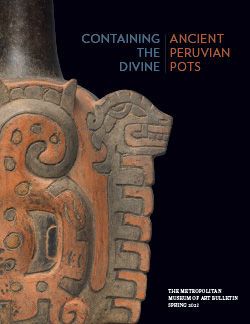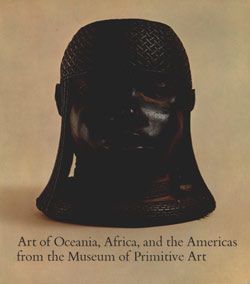Feline-shaped stirrup-spout bottle
Not on view
An unusual vessel shape known as the stirrup-spout bottle appeared with the Cupisnique culture on Peru’s north coast during the Formative period (1800–200 B.C.). The name “stirrup spout” refers to a bottle with a spout resembling the footrest of an equestrian saddle. This piece was said to have been found at the archaeological site of Tembladera (1200–800 B.C.) in the Jequetepeque Valley, where it was likely one of several prestigious objects placed in a grave. Its trapezoidal handle with a long, flaring neck is typical of the ceramic vessels from this region and is among the earliest examples in the Museum’s collection.
Elaborate stirrup-spouts are attached to chambers that are modeled or, in later periods, slip-painted. In this example, the body of the vessel is in the shape of a crouching feline. The figure was likely fired in a low oxygen environment, producing the dark grey-brown, almost black color. Before firing, its surface was burnished with a smooth tool, a technique that produces a polished finish. Concentric circles, known as circle-stamp motifs, were incised on the body; the chest and tail were engraved with horizontal lines. These markings suggest that the figure is a representation of a jaguar, ocelot, or pampas cat whose fur is decorated with a similar pattern.
Feline imagery is seen at both highland and coastal ceremonial centers across Peru beginning as early as the second millennium B.C. Although this piece is naturalistically rendered, the circle-stamp motif is also observed in abstract and stylized ceramic vessels, suggesting that the spotted pelt held symbolic meaning at several religious centers during this time. On this object, the cat’s limbs are clenched and tucked tightly to the torso, as if the animal were on the verge of pouncing. Furthermore, the creature's bared fangs and alert eyes suggest that it is targeting prey. The species’ predatorial nature and extensive range across the diverse Andean landscape are among the many reasons that felines were a common theme in early Peruvian art, redolent of cunning and power (Cordy-Collins 1998:155; Castillo and Pardo 2009:100).
Patricia A. Lagarde, Andrew W. Mellon Fellow, August 2021
References and further reading
Benson, Elizabeth P. Birds and Beasts of Ancient Latin America. Gainesville: University Press of Florida, 1997.
Burtenshaw-Zumstein, Julia. “Cupisnique, Tembladera, Chongoyape, Chavín?: A Typology of Ceramic Styles from Formative Period Northern Peru, 1800–200 B.C.” Ph.D. Dissertation, University of East Anglia, 2014.
Castillo, Luis Jamie and Cecilia Pardo (eds.). De Cupisnique a los Incas. El arte del valle de Jequetepeque. Lima: Asociación Museo de Arte de Lima, 2009.
Cordy-Collins, Alana. “The Jaguar of the Backward Glance,” in Icons of Power: Feline Symbolism in the Americas, edited by Nicholas J. Saunders, pp. 155–70. London: Routledge, 1998.
Elera, Carlos G. “La cultura Cupisnique a partir de los datos arqueológicos de Puémape,” in De Cupisnique a los Incas. El arte del valle de Jequetepeque, edited by Luis Jamie Castillo and Cecilia Pardo, pp. 68–75. Lima: Asociación Museo de Arte de Lima, 2009.
Fux, Peter (ed.). Chavín: Peru’s Enigmatic Temple in the Andes. Zurich: Museum Rietberg; Scheidegger & Spiess, 2013.
Due to rights restrictions, this image cannot be enlarged, viewed at full screen, or downloaded.
This artwork is meant to be viewed from right to left. Scroll left to view more.






